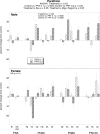Diazinon and parathion diverge in their effects on development of noradrenergic systems
- PMID: 28235599
- PMCID: PMC5406256
- DOI: 10.1016/j.brainresbull.2017.02.004
Diazinon and parathion diverge in their effects on development of noradrenergic systems
Abstract
Organophosphate pesticides elicit developmental neurotoxicity through mechanisms over and above their shared property as cholinesterase inhibitors. We compared the consequences of neonatal exposure (postnatal days PN1-4) to diazinon or parathion on development of norepinephrine systems in rat brain, using treatments designed to produce equivalent effects on cholinesterase, straddling the threshold for barely-detectable inhibition. Norepinephrine levels were measured throughout development from the immediate posttreatment period (PN5), to early adolescence (PN30), young adulthood (PN60) and full adulthood (PN100); we assessed multiple brain regions containing all the major noradrenergic synaptic projections. Diazinon elicited a significant overall deficit of norepinephrine, whereas parathion produced a net increase. The effects were not immediately apparent (PN5) but rather emerged over the course of development, indicating that the organophosphate effects represent alteration of the trajectory of development, not just continuance of an initial injury. There were no comparable effects on β-adrenergic receptors, indicating that the presynaptic changes were not an adaptation to an underlying, primary effect on postsynaptic receptor signaling. Because we used the cholinesterase inhibition benchmark, the absolute dose of diazinon was much higher than that of parathion, since the latter is a more potent cholinesterase inhibitor. Our results are consistent with the growing evidence that the various organophosphates can differ in their impact on brain development and that consequently, the cholinesterase benchmark is an inadequate predictor of adverse neurodevelopmental effects.
Keywords: Brain development; Diazinon; Norepinephrine; Organophosphate pesticides; Parathion; β-Adrenergic receptor.
Copyright © 2017 Elsevier Inc. All rights reserved.
Conflict of interest statement
Figures




Similar articles
-
Exposure of neonatal rats to parathion elicits sex-selective impairment of acetylcholine systems in brain regions during adolescence and adulthood.Environ Health Perspect. 2008 Oct;116(10):1308-14. doi: 10.1289/ehp.11451. Epub 2008 May 19. Environ Health Perspect. 2008. PMID: 18941570 Free PMC article.
-
Organophosphate insecticides target the serotonergic system in developing rat brain regions: disparate effects of diazinon and parathion at doses spanning the threshold for cholinesterase inhibition.Environ Health Perspect. 2006 Oct;114(10):1542-6. doi: 10.1289/ehp.9337. Environ Health Perspect. 2006. PMID: 17035140 Free PMC article.
-
Developmental neurotoxicity of parathion: progressive effects on serotonergic systems in adolescence and adulthood.Neurotoxicol Teratol. 2009 Jan-Feb;31(1):11-7. doi: 10.1016/j.ntt.2008.08.004. Epub 2008 Aug 20. Neurotoxicol Teratol. 2009. PMID: 18773955 Free PMC article.
-
Does early-life exposure to organophosphate insecticides lead to prediabetes and obesity?Reprod Toxicol. 2011 Apr;31(3):297-301. doi: 10.1016/j.reprotox.2010.07.012. Epub 2010 Sep 17. Reprod Toxicol. 2011. PMID: 20850519 Free PMC article. Review.
-
Novel approaches to mitigating parathion toxicity: targeting cytochrome P450-mediated metabolism with menadione.Ann N Y Acad Sci. 2016 Aug;1378(1):80-86. doi: 10.1111/nyas.13156. Epub 2016 Jul 21. Ann N Y Acad Sci. 2016. PMID: 27441453 Free PMC article. Review.
Cited by
-
Single neonatal dexamethasone administration has long-lasting outcome on depressive-like behaviour, Bdnf, Nt-3, p75ngfr and sorting receptors (SorCS1-3) stress reactive expression.Sci Rep. 2021 Apr 14;11(1):8092. doi: 10.1038/s41598-021-87652-7. Sci Rep. 2021. PMID: 33854153 Free PMC article.
-
Perinatal diazinon exposure compromises the development of acetylcholine and serotonin systems.Toxicology. 2019 Aug 1;424:152240. doi: 10.1016/j.tox.2019.152240. Epub 2019 Jun 25. Toxicology. 2019. PMID: 31251962 Free PMC article.
-
The organophosphate insecticide diazinon and aging: Neurobehavioral and mitochondrial effects in zebrafish exposed as embryos or during aging.Neurotoxicol Teratol. 2021 Sep-Oct;87:107011. doi: 10.1016/j.ntt.2021.107011. Epub 2021 Jul 2. Neurotoxicol Teratol. 2021. PMID: 34224825 Free PMC article.
-
Differences in neurotoxic outcomes of organophosphorus pesticides revealed via multi-dimensional screening in adult and regenerating planarians.Front Toxicol. 2022 Oct 4;4:948455. doi: 10.3389/ftox.2022.948455. eCollection 2022. Front Toxicol. 2022. PMID: 36267428 Free PMC article.
References
-
- Clegg DJ, van Gemert M. Determination of the reference dose for chlorpyrifos: proceedings of an expert panel. J Toxicol Environ Health. 1999;2:211–255. - PubMed
-
- Dam K, Garcia SJ, Seidler FJ, Slotkin TA. Neonatal chlorpyrifos exposure alters synaptic development and neuronal activity in cholinergic and catecholaminergic pathways. Dev Brain Res. 1999;116:9–20. - PubMed
-
- Mahaboob Basha P, Begum S, Nayeemunnisa Methyl parathion induced alterations in monoaminergic system of developing rat pups. Indian J Exp Biol. 2001;39:276–279. - PubMed
Publication types
MeSH terms
Substances
Grants and funding
LinkOut - more resources
Full Text Sources
Other Literature Sources
Miscellaneous

